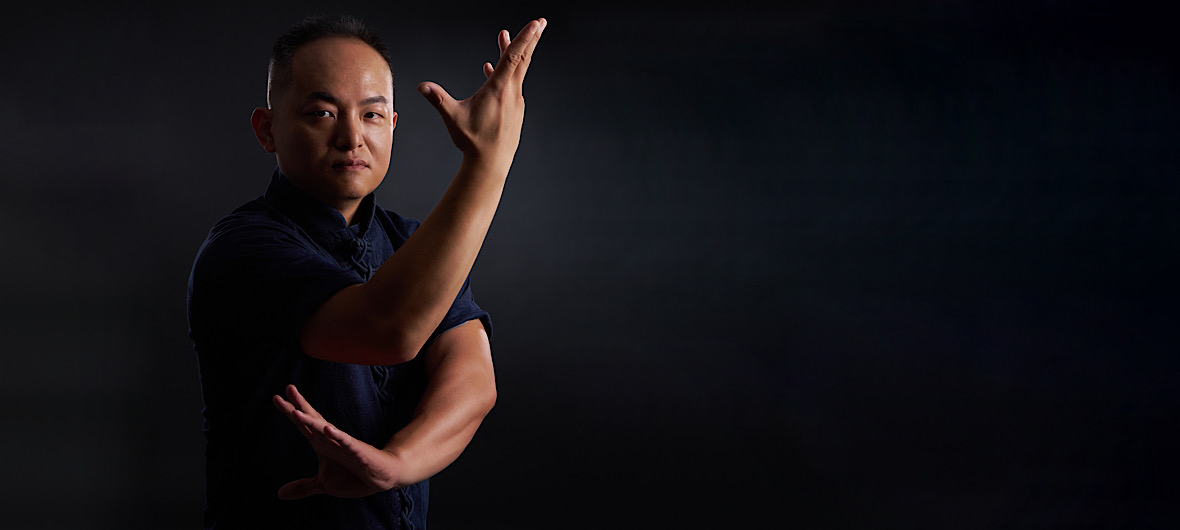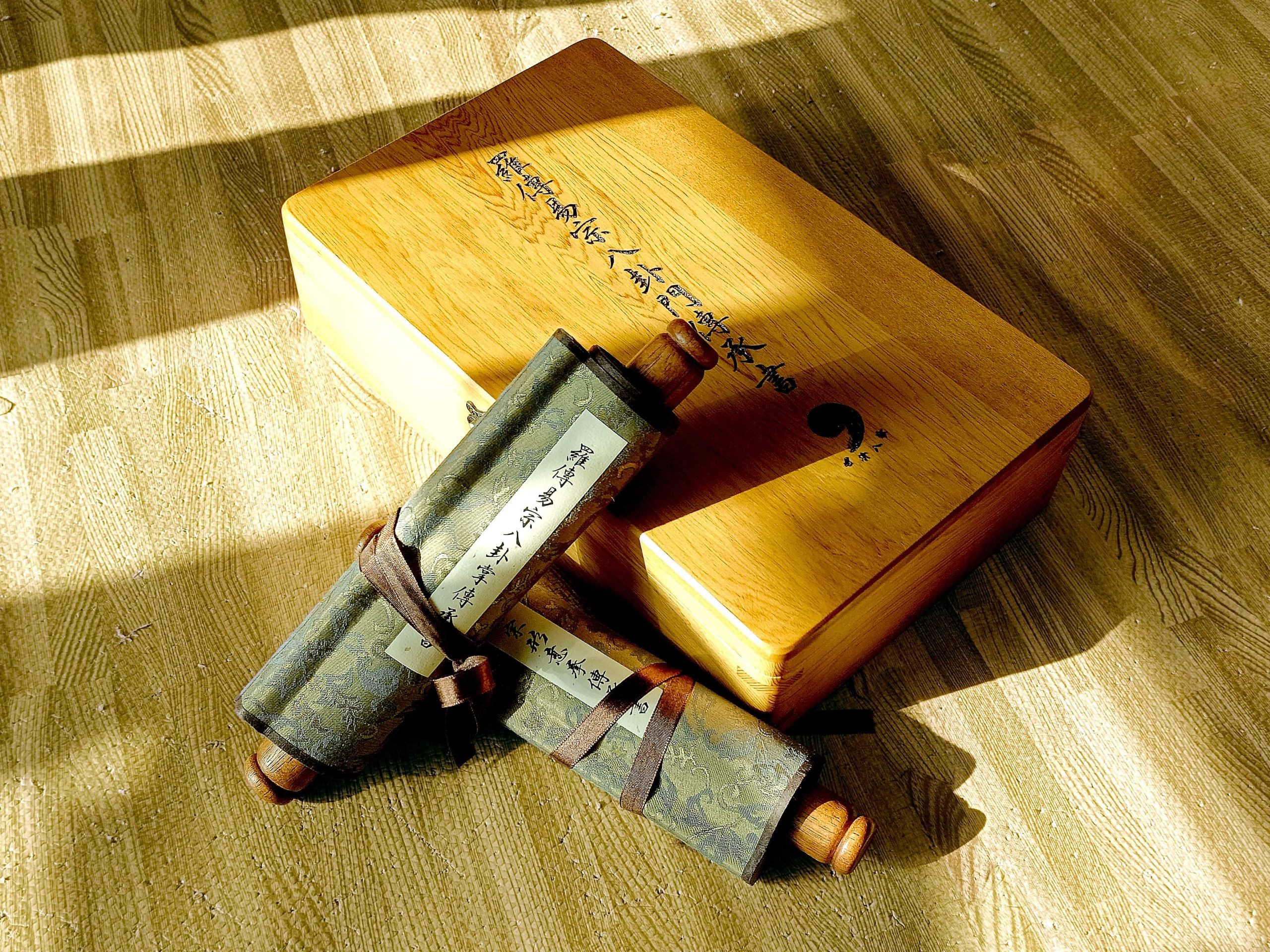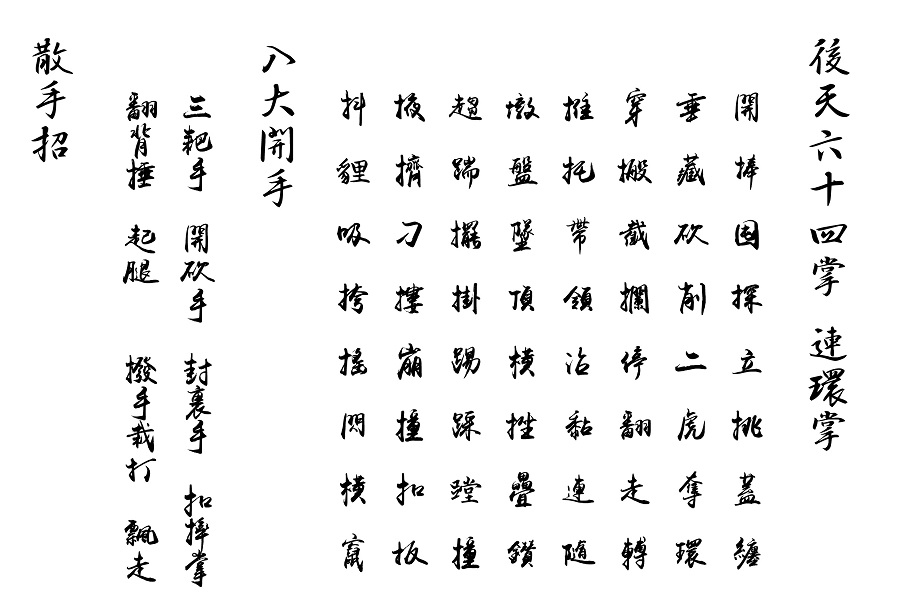Luo's Yizong Bagua Zhang
Bagua Zhang
Table of Contents

Post-Heaven First Trigram (Kai, Peng, Dun, Tan, Li, Tiao, Gai, Chan)
The main training goal is to familiarize oneself with the structural strength of the body and understand how certain posture combinations create formations with strong rigidity that are resistant to collapsing or losing balance. In continuous movements, the focus is on the "gradual technique," where the end of each move maintains forward tension, providing a foundation for the next movement to begin.
Post-Heaven Second Trigram (Chui, Cang, Kan, Xue, Er, Hu, Duo, Huan)
The primary training goal is to develop the body’s opening and closing, expanding and contracting with force. The fluidity of motion depends on the transition between expansion and contraction. This natural rhythm enhances breathing and improves cardiovascular endurance. To increase strength, one can push the movement to its full extent and hold it longer, extending the comfortable range of power. To enhance fluidity, one can attempt to switch between expansion and contraction before the movement reaches its endpoint, smoothing the rhythm and avoiding noticeable pauses that can be exploited by the opponent. In continuous movements, the focus is on ensuring smooth transitions between hand techniques without interruption.
The main training goal is to familiarize oneself with the structural strength of the body and understand how certain posture combinations create formations with strong rigidity that are resistant to collapsing or losing balance. In continuous movements, the focus is on the "gradual technique," where the end of each move maintains forward tension, providing a foundation for the next movement to begin.
Post-Heaven Second Trigram (Chui, Cang, Kan, Xue, Er, Hu, Duo, Huan)
The primary training goal is to develop the body’s opening and closing, expanding and contracting with force. The fluidity of motion depends on the transition between expansion and contraction. This natural rhythm enhances breathing and improves cardiovascular endurance. To increase strength, one can push the movement to its full extent and hold it longer, extending the comfortable range of power. To enhance fluidity, one can attempt to switch between expansion and contraction before the movement reaches its endpoint, smoothing the rhythm and avoiding noticeable pauses that can be exploited by the opponent. In continuous movements, the focus is on ensuring smooth transitions between hand techniques without interruption.

Post-Heaven Third Trigram (Chuan, Ban, Jie, Lan, Ning, Fan, Zou, Zhuan)
This training focuses on utilizing one's own momentum and inertia to perform collisions from various angles. The force of the collision can follow the opponent’s change in direction, disrupting their balance. In simple terms, it's about using your own movement to strike the opponent. The practice in continuous movements is "moving back and forth," honing the ability to control and use momentum effectively in every strike.
Post-Heaven Fourth Trigram (Tui, Tuo, Dai, Ling, Zhan, Nian, Lian, Sui)
This method involves using the opponent’s momentum to strike in harmony with their movement. To use their momentum effectively, you must first lead and guide them into motion, creating an inertia that can be exploited for a collision or throw. The fourth trigram demonstrates various combinations of leading, following, and changing the direction of force. The techniques shown are examples, and the emphasis is not on the external form of the movements, but rather on the skill and timing of applying force. The practice in continuous movements is "releasing power" or "generating force."
This training focuses on utilizing one's own momentum and inertia to perform collisions from various angles. The force of the collision can follow the opponent’s change in direction, disrupting their balance. In simple terms, it's about using your own movement to strike the opponent. The practice in continuous movements is "moving back and forth," honing the ability to control and use momentum effectively in every strike.
Post-Heaven Fourth Trigram (Tui, Tuo, Dai, Ling, Zhan, Nian, Lian, Sui)
This method involves using the opponent’s momentum to strike in harmony with their movement. To use their momentum effectively, you must first lead and guide them into motion, creating an inertia that can be exploited for a collision or throw. The fourth trigram demonstrates various combinations of leading, following, and changing the direction of force. The techniques shown are examples, and the emphasis is not on the external form of the movements, but rather on the skill and timing of applying force. The practice in continuous movements is "releasing power" or "generating force."

Post-Heaven Fifth Trigram (Dun, Pan, Zhui, Ding, Heng, Cuo, Die, Zhuan)
The elbow technique is characterized by a rigid structure and great power, but with a short range. It is often used as a concealed strike for pursuing and capturing the opponent, typically as part of a continuous attack and rarely used on its own. The fifth trigram demonstrates various restraining techniques combined with elbow strikes. Due to the limited range of elbow strikes, there is no continuous movement practice for this technique, as the focus is on integrating it as a finishing move in a series of attacks.
Post-Heaven Sixth Trigram (Qu, Chai, Bai, Gua, Ti, Cai, Tang, Zhuang)
The leg techniques serve as the "third hand," complementing the hand techniques. They are divided into obvious (or "bright") and concealed (or "dark") legs. Bright leg techniques are executed after hand techniques have created a specific structure, with a clear attack target in mind. Dark leg techniques, on the other hand, are employed during movement, with the leg being casually extended, increasing the likelihood of a successful strike. For example, when advancing, one might slightly raise the foot and stomp down—if it lands, great; if not, it doesn't matter. Due to the lack of a defined target or intention, dark leg techniques are harder for the opponent to detect. The training focus in continuous movements is on coordinating the hands and feet in such a way that they do not hinder each other’s motion.
The elbow technique is characterized by a rigid structure and great power, but with a short range. It is often used as a concealed strike for pursuing and capturing the opponent, typically as part of a continuous attack and rarely used on its own. The fifth trigram demonstrates various restraining techniques combined with elbow strikes. Due to the limited range of elbow strikes, there is no continuous movement practice for this technique, as the focus is on integrating it as a finishing move in a series of attacks.
Post-Heaven Sixth Trigram (Qu, Chai, Bai, Gua, Ti, Cai, Tang, Zhuang)
The leg techniques serve as the "third hand," complementing the hand techniques. They are divided into obvious (or "bright") and concealed (or "dark") legs. Bright leg techniques are executed after hand techniques have created a specific structure, with a clear attack target in mind. Dark leg techniques, on the other hand, are employed during movement, with the leg being casually extended, increasing the likelihood of a successful strike. For example, when advancing, one might slightly raise the foot and stomp down—if it lands, great; if not, it doesn't matter. Due to the lack of a defined target or intention, dark leg techniques are harder for the opponent to detect. The training focus in continuous movements is on coordinating the hands and feet in such a way that they do not hinder each other’s motion.

Post-Heaven Seventh Trigram (Ye, Ji, Diao, Lou, Beng, Zhuang, Kou, Ban)
The focus of the seventh trigram lies in the wrist's hooking, twisting, and entangling actions, extending the awareness and body sensation from the core torso to the tips of the wrists. This practice helps develop the habit of trapping the opponent's hands and familiarizes the practitioner with responses once the hands are engaged. Due to the small movement range of the wrist, the techniques of the seventh trigram must be complemented by corresponding footwork for proper execution. This is why some practitioners describe the seventh trigram as being a study of footwork. The training in continuous movements focuses on transitioning smoothly from one technique to another, especially when the first strike has not yet succeeded—connecting and flowing between techniques.
Post-Heaven Eighth Trigram (Dao, Li, Xi, Kua, Yao, Shan, Heng, Chuan)
In contrast to the seventh trigram, the eighth focuses on body movements. The awareness shifts from the extremities back to the torso, with twisting and turning actions of the core driving the entire body's movement. Known as the "Eight Forms" or "Eight Characteristics," it connects eight distinct ways of using the body. The core muscle groups of the torso are characterized by great strength but limited range of motion. Therefore, after awakening the corresponding muscle groups with individual techniques, continuous training of linked movements helps activate the torso's responsiveness. This allows for fluid, uninterrupted torso motions and dynamic force changes in continuous practice.
The focus of the seventh trigram lies in the wrist's hooking, twisting, and entangling actions, extending the awareness and body sensation from the core torso to the tips of the wrists. This practice helps develop the habit of trapping the opponent's hands and familiarizes the practitioner with responses once the hands are engaged. Due to the small movement range of the wrist, the techniques of the seventh trigram must be complemented by corresponding footwork for proper execution. This is why some practitioners describe the seventh trigram as being a study of footwork. The training in continuous movements focuses on transitioning smoothly from one technique to another, especially when the first strike has not yet succeeded—connecting and flowing between techniques.
Post-Heaven Eighth Trigram (Dao, Li, Xi, Kua, Yao, Shan, Heng, Chuan)
In contrast to the seventh trigram, the eighth focuses on body movements. The awareness shifts from the extremities back to the torso, with twisting and turning actions of the core driving the entire body's movement. Known as the "Eight Forms" or "Eight Characteristics," it connects eight distinct ways of using the body. The core muscle groups of the torso are characterized by great strength but limited range of motion. Therefore, after awakening the corresponding muscle groups with individual techniques, continuous training of linked movements helps activate the torso's responsiveness. This allows for fluid, uninterrupted torso motions and dynamic force changes in continuous practice.



